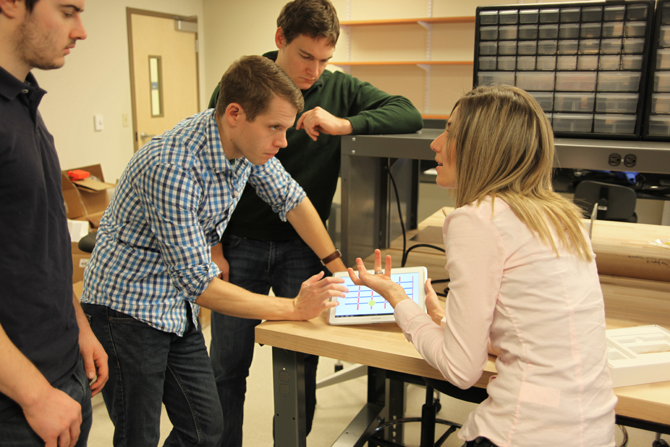Professor Awarded $150,000 NSF Grant for Research to Benefit Visually Impaired Students
Jenna Gorlewicz, Ph.D., assistant professor of aerospace and mechanical engineering, was awarded $150,000 for her research, "Ushering in a New Paradigm of Real-Time Tactile Graphics for Visually Impaired Students."
Her work introduces a new type of tactile learning for blind and visually impaired (BVI) students, especially in science, technology, engineering and math (STEM). Historically, BVI students have been at a significant disadvantage compared to their sighted peers. When sighted students are learning things in a visual way, BVI students tend to have incredibly limited access, often relying on the recreation of the material through tools such as embossed graphics or manipulatives.
Gorlewicz and her team are introducing the idea of "seeing graphics" through touch, and specifically, vibrations. By using commercially available touchscreen technology, her group is introducing software that converts an image into something that can not only be seen, but also felt through vibrations and heard through various sounds. This type of technology represents a significant paradigm shift in tactile graphics, but has the potential to be a game-changer in making STEM fields more accessible for BVI students.
This grant will allow for Gorlewicz and her team to complete two studies. The first explores line-following on touch screens using vibrations, which is surprisingly difficult. The second will introduce these touch screens in the classroom setting to gauge the learning benefits for BVI and sighted students and understand necessary features from a teaching perspective. For these in-classroom studies, Gorlewicz and her team will partner with the Illinois School for the Visually Impaired, a local Missouri public elementary school, an elementary school in Arizona, and Manhattan College in New York.
Gorlewicz's involvement in this type of work serves two purposes. She has always been intrigued by technology, and she also wanted to use engineering to benefit people. This project enables her to put her two passions together into one incredible endeavor.
"This project is about creating accessible, equal opportunities in STEM education for students of all learning styles," she said. "It's a hefty challenge, but when you work with the students and their teachers and you see the drive and the capabilities that they have, you can't help but want to give them the tools they deserve to succeed. It's just incredibly professionally and personally rewarding to be able to work on this project and hopefully, bring about a better tomorrow in STEM education."
This project is about creating accessible, equal opportunities in STEM education for students of all learning styles," she said. "It's a hefty challenge, but when you work with the students and their teachers and you see the drive and the capabilities that they have, you can't help but want to give them the tools they deserve to succeed. It's just incredibly professionally and personally rewarding to be able to work on this project and hopefully, bring about a better tomorrow in STEM education.
Additionally, for her work in broadening accessibility of STEM in K-12 education, Gorlewicz was invited to participate in an NSF-supported "Next Generation STEM Learning for ALL forum to discuss the most important areas of STEM education in November. From this forum, many ideas were brought forth to a larger White House Next Generation High School Summit on the same topic.
If successful, Gorlewicz hopes to continue her findings in Phase Two of the grant. This would be a $750,000 endeavor that would further incorporate the technology into classrooms across the country.


















